INSTITUT SUPERIEUR D'ANTHROPOLOGIE
INSTITUTE OF ANTHROPOLOGY
ONLINE COURSES / COURS A DISTANCE
SPRING SESSION : APRIL 2013
REGISTER NOW
FRANCE – 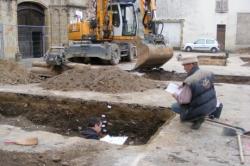 Aire sur l’Adour - En janvier 2012, à l’occasion de fouilles préalables à de nouveaux travaux à la cathédrale d’Aire-sur-l’Adour et dans l’ancien cloître attenant, les archéologues de l’Inrap (Institut national de recherches archéologiques préventives) faisaient de nombreuses découvertes. Une partie du parvis de la cathédrale, devant l’entrée principale, semble être l’extrémité ouest de la nef de l’ancienne cathédrale romane, qui s’avançait beaucoup plus vers la rue Gambetta, longeant le bâtiment actuel. Mais d’autres découvertes confirment l’hypothèse que la cité aturine a été construite sur une occupation antique conséquente. Les archéologues ont trouvé des traces de murs et de sols de béton de tuileau, constitués avec mortier, chaux, sable et une masse de briques et de tuiles cassées. Ce dispositif romain permettait de chauffer la pièce par hypocauste (chauffage par le sol) . Dans ce contexte, la découverte d’une pièce à eau indique que l’on avait affaire à des soins thermaux, le chauffage par hypocauste étant dans l’Antiquité surtout utilisé dans les thermes romains. Cependant, impossible de savoir si c’était le bien d’un particulier fortuné, ou l’équipement d’un établissement public. En tout cas, la date de construction est estimée entre la fin du Haut Empire et le Bas Empire, soit dans les premiers siècles après Jésus-Christ. La nouveauté révélée par ces fouilles consiste en la mise au jour d’une occupation du sol entre ces deux époques, l’Antiquité et la fin du Moyen Âge. Un passé médiéval qui, lui, fut établi par la découverte de nombreux squelettes témoins de l’existence d’un cimetière autour de la cathédrale, ce qui était fréquent à cette période. La présence de constructions massives en galets et mortiers, avec des blocs calcaires qui s’appuient directement sur les couches inférieures, laisse à penser qu’il y avait là un bâtiment postérieur à l’Antiquité, construit avant les prémices de la cathédrale actuelle. Peut-être un ancien édifice religieux, peut-être autre chose. De plus, le mobilier en céramique et les différents objets retrouvés, attribuables aux règnes d’Auguste et de Tibère, confirment la datation de cette occupation des terrasses naturelles aturines entre le Ier siècle avant J.-C. et le IIe siècle après. Pour en savoir plus, il faudrait sans doute creuser plus profond et sur une plus grande durée. Les archéologues ont en effet seulement creusé quatre tranchées sous le parvis de la cathédrale et deux dans une cour intérieure de l’hôtel de ville (certaines jusqu’à plus de trois mètres de profondeur). Mais la décision de poursuivre ces recherches ne leur appartient pas, puisque c’est du ressort de la Drac (Direction régionale des affaires culturelles).
Aire sur l’Adour - En janvier 2012, à l’occasion de fouilles préalables à de nouveaux travaux à la cathédrale d’Aire-sur-l’Adour et dans l’ancien cloître attenant, les archéologues de l’Inrap (Institut national de recherches archéologiques préventives) faisaient de nombreuses découvertes. Une partie du parvis de la cathédrale, devant l’entrée principale, semble être l’extrémité ouest de la nef de l’ancienne cathédrale romane, qui s’avançait beaucoup plus vers la rue Gambetta, longeant le bâtiment actuel. Mais d’autres découvertes confirment l’hypothèse que la cité aturine a été construite sur une occupation antique conséquente. Les archéologues ont trouvé des traces de murs et de sols de béton de tuileau, constitués avec mortier, chaux, sable et une masse de briques et de tuiles cassées. Ce dispositif romain permettait de chauffer la pièce par hypocauste (chauffage par le sol) . Dans ce contexte, la découverte d’une pièce à eau indique que l’on avait affaire à des soins thermaux, le chauffage par hypocauste étant dans l’Antiquité surtout utilisé dans les thermes romains. Cependant, impossible de savoir si c’était le bien d’un particulier fortuné, ou l’équipement d’un établissement public. En tout cas, la date de construction est estimée entre la fin du Haut Empire et le Bas Empire, soit dans les premiers siècles après Jésus-Christ. La nouveauté révélée par ces fouilles consiste en la mise au jour d’une occupation du sol entre ces deux époques, l’Antiquité et la fin du Moyen Âge. Un passé médiéval qui, lui, fut établi par la découverte de nombreux squelettes témoins de l’existence d’un cimetière autour de la cathédrale, ce qui était fréquent à cette période. La présence de constructions massives en galets et mortiers, avec des blocs calcaires qui s’appuient directement sur les couches inférieures, laisse à penser qu’il y avait là un bâtiment postérieur à l’Antiquité, construit avant les prémices de la cathédrale actuelle. Peut-être un ancien édifice religieux, peut-être autre chose. De plus, le mobilier en céramique et les différents objets retrouvés, attribuables aux règnes d’Auguste et de Tibère, confirment la datation de cette occupation des terrasses naturelles aturines entre le Ier siècle avant J.-C. et le IIe siècle après. Pour en savoir plus, il faudrait sans doute creuser plus profond et sur une plus grande durée. Les archéologues ont en effet seulement creusé quatre tranchées sous le parvis de la cathédrale et deux dans une cour intérieure de l’hôtel de ville (certaines jusqu’à plus de trois mètres de profondeur). Mais la décision de poursuivre ces recherches ne leur appartient pas, puisque c’est du ressort de la Drac (Direction régionale des affaires culturelles).
http://www.sudouest.fr/2013/03/06/fouilles-antiques-985937-3269.php
ROYAUME UNI – 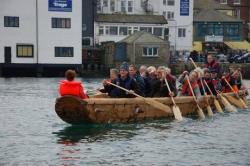 Ferriby – The rigour of prehistoric seafaring has been tested as archaeologists launched Britain’s first ever full-size reconstructed sea-going Bronze Age boat. The 15 metre long experimental vessel – a replica of the sort of craft used for long-distance trade between Britain and the continent 4000 years ago – was launched in Falmouth Cornwall at midday with a crew of 18, equipped with Bronze-Age-style wooden paddles. In good old maritime tradition (but with a nod to the long-lost Bronze Age past), the vessel slid into the water with a little alcoholic help – not from champagne, but from traditional Cornish mead poured from a replica Bronze Age ceramic drinking vessel. Testing the newly constructed Bronze-Age-style vessel both in the water, and through a computer program, will have revealed its cargo-carrying capacity, its stability, its speed, its manoeuvrability and its ability to cope with rough water. Studies of prehistoric vessels from all over Europe suggest that, in around 2000 BC, Britain was very much in the lead when it came to ship-building and seafaring. For much of the past 4000 years, the North Sea region – comprising Britain, Scandinavia and the Low Countries – has been one of the key areas of the world at the cutting edge of marine engineering. In many ways, the development of sea-going sewn-plank-built vessels – probably in Britain (where parts of ten examples have been found) – was the beginning of that long and complex process. Other important steps forward in maritime technology – the invention of fast light-weight vessels (made from ultra-thin planks), the introduction of aggressive-looking ‘horse-head’ prows and the introduction of equally streamlined sterns appear to have been developed in the region by 1700 BC, 1400BC and 500BC respectively, according to on-going research into tens of thousands of Scandinavian rock art depictions of boats, analysed by archaeologists at Denmark’s National Museum in Copenhagen and Gothenburg University, Sweden. As early as 1700 BC, some vessels may possibly have been up to 35 metres in length. Two of the subsequent great pieces of maritime engineering technology, overlapping riveted planking and the keel, were also invented within the North Sea region – probably in southern Scandinavia by around 200 and 300 AD, respectively – and will be published by the Centre for Scandinavian and Baltic Archaeology in Schleswig, Denmark later this year. The precursor of the modern rudder was also first developed in the region – in the 12th century. The vessel – based on the ones excavated at Ferriby on the north bank of the Humber estuary in 1963 – needs a crew of 18 to 20 relatively muscular individuals to get her to operate at full power. The replica Bronze Age craft has been built, mainly by volunteers, at the National Maritime Museum Cornwall in Falmouth – in collaboration with prehistorian, Professor Robert Van de Noort of Exeter University.
Ferriby – The rigour of prehistoric seafaring has been tested as archaeologists launched Britain’s first ever full-size reconstructed sea-going Bronze Age boat. The 15 metre long experimental vessel – a replica of the sort of craft used for long-distance trade between Britain and the continent 4000 years ago – was launched in Falmouth Cornwall at midday with a crew of 18, equipped with Bronze-Age-style wooden paddles. In good old maritime tradition (but with a nod to the long-lost Bronze Age past), the vessel slid into the water with a little alcoholic help – not from champagne, but from traditional Cornish mead poured from a replica Bronze Age ceramic drinking vessel. Testing the newly constructed Bronze-Age-style vessel both in the water, and through a computer program, will have revealed its cargo-carrying capacity, its stability, its speed, its manoeuvrability and its ability to cope with rough water. Studies of prehistoric vessels from all over Europe suggest that, in around 2000 BC, Britain was very much in the lead when it came to ship-building and seafaring. For much of the past 4000 years, the North Sea region – comprising Britain, Scandinavia and the Low Countries – has been one of the key areas of the world at the cutting edge of marine engineering. In many ways, the development of sea-going sewn-plank-built vessels – probably in Britain (where parts of ten examples have been found) – was the beginning of that long and complex process. Other important steps forward in maritime technology – the invention of fast light-weight vessels (made from ultra-thin planks), the introduction of aggressive-looking ‘horse-head’ prows and the introduction of equally streamlined sterns appear to have been developed in the region by 1700 BC, 1400BC and 500BC respectively, according to on-going research into tens of thousands of Scandinavian rock art depictions of boats, analysed by archaeologists at Denmark’s National Museum in Copenhagen and Gothenburg University, Sweden. As early as 1700 BC, some vessels may possibly have been up to 35 metres in length. Two of the subsequent great pieces of maritime engineering technology, overlapping riveted planking and the keel, were also invented within the North Sea region – probably in southern Scandinavia by around 200 and 300 AD, respectively – and will be published by the Centre for Scandinavian and Baltic Archaeology in Schleswig, Denmark later this year. The precursor of the modern rudder was also first developed in the region – in the 12th century. The vessel – based on the ones excavated at Ferriby on the north bank of the Humber estuary in 1963 – needs a crew of 18 to 20 relatively muscular individuals to get her to operate at full power. The replica Bronze Age craft has been built, mainly by volunteers, at the National Maritime Museum Cornwall in Falmouth – in collaboration with prehistorian, Professor Robert Van de Noort of Exeter University.
http://www.independent.co.uk/news/science/archaeology/it-didnt-sink-success-as-fullsize-sewntogether-replica-of-a-bronze-age-boat-floats-8521472.html
MYANMAR – 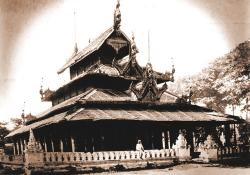 Mandalay - Craftsmen will use traditional Myanmar building methods to restore three historic buildings from the era of King Mindon. The three buildings are the Pahtan-haw Shwe Thein high ordination hall, the Thudhamma Zayats and Pitakat Taik Taw, the Buddhist scripture library. In 1857, King Mindon founded a new royal capital at the foot of Mandalay Hill, based around seven royal buildings sited on the advice of astrologers. All but the moat and the Kuthodaw Pagoda were destroyed by fire in the war of 1890. The Atumashi Monastery has since been rebuilt as a faithful replica of the original, and the royal wall has been repaired. The three remaining structures will now be renovated under the supervision of Thetagu Sayardaw U Nyanissara and Tampawaddy U Win Maung. Thetagu Sayardaw is a monk known for his public work, including hefty donations for the building of a water supply system in Sagaing Region, a 100-bed hospital for monks, nuns, novices and poor people in Sagaing and the construction of the International Buddhist Academy.
Mandalay - Craftsmen will use traditional Myanmar building methods to restore three historic buildings from the era of King Mindon. The three buildings are the Pahtan-haw Shwe Thein high ordination hall, the Thudhamma Zayats and Pitakat Taik Taw, the Buddhist scripture library. In 1857, King Mindon founded a new royal capital at the foot of Mandalay Hill, based around seven royal buildings sited on the advice of astrologers. All but the moat and the Kuthodaw Pagoda were destroyed by fire in the war of 1890. The Atumashi Monastery has since been rebuilt as a faithful replica of the original, and the royal wall has been repaired. The three remaining structures will now be renovated under the supervision of Thetagu Sayardaw U Nyanissara and Tampawaddy U Win Maung. Thetagu Sayardaw is a monk known for his public work, including hefty donations for the building of a water supply system in Sagaing Region, a 100-bed hospital for monks, nuns, novices and poor people in Sagaing and the construction of the International Buddhist Academy.
http://www.mmtimes.com/index.php/national-news/mandalay-upper-myanmar/4267-three-royal-buildings-in-mandalay-to-be-restored.html
GRECE – 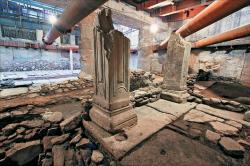 Thessalonique - The municipal council of Thessaloniki has listened to the archaeologists and the “Attiko Metro” company representatives, and to what each side had to say about the moving or the in situ maintenance of the findings revealed during the works at the metro station “Venizelos”. The moving of the antiquities would be a crime and an insult for the city, as the Central Archaeological Council decided, stressed the mayor of Thessaloniki, Giannis Boutaris. Mr. Boutaris stands in favor of the in situ maintenance of the antiquities and added that there is no unsolvable technical problem.
Thessalonique - The municipal council of Thessaloniki has listened to the archaeologists and the “Attiko Metro” company representatives, and to what each side had to say about the moving or the in situ maintenance of the findings revealed during the works at the metro station “Venizelos”. The moving of the antiquities would be a crime and an insult for the city, as the Central Archaeological Council decided, stressed the mayor of Thessaloniki, Giannis Boutaris. Mr. Boutaris stands in favor of the in situ maintenance of the antiquities and added that there is no unsolvable technical problem.
http://www.archaiologia.gr/en/blog/2013/03/06/g-boutaris-moving-the-antiquities-would-be-a-crime-and-an-insult-for-the-city/
GRECE – 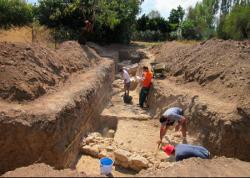 Amarynthos - The Swiss School of Archaeology is in search of the temple of Artemis Amarynhtia in Euboea, a famous open-air sanctuary of Antiquity and the end point of the procession of the Eretreans who participated at the Amarynhtia, the annual festival in honor of Artemis. And it seems that the archaeologists are very close in finding it. At Amarynthos, one of the most significant archaeological sites of Euboea, Swiss archaeologists have located in 2007 parts of a massive wall dating back to the Classical Era, which probably belongs to the Stoa (portico) which was built within the immediate surroundings of the temple. In 2012, the surveys continued, and the Swiss team brought to light a bigger part of the building. So far, a part of 20 m length has been revealed. Artemision of Amarynthos was very important to the inhabitants of the area. There, the Eretrians kept the stone stelae which contained their treaties – e.g., the agreement between Eretria and Chalkis about the Lelantine Plain. It should be noted that in the magnificent procession for the Amarynthia (mentioned by Strabo, 63 BC-24 AD), 3,000 hoplites, 600 horsemen and 60 chariots participated. Later, the festival was transferred to Attica, in the Athmon Deme, and was named Amarysia, giving its name to the new festival location (today’s Marousi). During the annual meeting, Mr. Reber will also refer to the excavation results at the Roman baths of Eretria, which date back to the middle of the 2nd century AD, and are located very close to the famous House with the Mosaics. The surveys of 2012 have focused on the investigation of the baths’ ground plan, the examination of the various phases of the monument, and the changes the rooms underwent while the baths were in use. In 2013, the surveys will focus on the examination of these results.The annual meeting will close with a lecture given by Professor of Classical Archaeology at the Geneva University Lorenz Baumer, who will present the results of the first excavations and the new research perspectives opened up at the site of the ancient city of Kroton, in the Calabria region. In 2010, the University of Geneva started in direct cooperation with the Ufficio Territoriale di Crotone e della Sila of the Soprintendenza per i Beni Archeologici della Calabria and its director Dr. Domenico Marino a new research initiative, aiming at a better comprehension of the city of Kroton and its territory.
Amarynthos - The Swiss School of Archaeology is in search of the temple of Artemis Amarynhtia in Euboea, a famous open-air sanctuary of Antiquity and the end point of the procession of the Eretreans who participated at the Amarynhtia, the annual festival in honor of Artemis. And it seems that the archaeologists are very close in finding it. At Amarynthos, one of the most significant archaeological sites of Euboea, Swiss archaeologists have located in 2007 parts of a massive wall dating back to the Classical Era, which probably belongs to the Stoa (portico) which was built within the immediate surroundings of the temple. In 2012, the surveys continued, and the Swiss team brought to light a bigger part of the building. So far, a part of 20 m length has been revealed. Artemision of Amarynthos was very important to the inhabitants of the area. There, the Eretrians kept the stone stelae which contained their treaties – e.g., the agreement between Eretria and Chalkis about the Lelantine Plain. It should be noted that in the magnificent procession for the Amarynthia (mentioned by Strabo, 63 BC-24 AD), 3,000 hoplites, 600 horsemen and 60 chariots participated. Later, the festival was transferred to Attica, in the Athmon Deme, and was named Amarysia, giving its name to the new festival location (today’s Marousi). During the annual meeting, Mr. Reber will also refer to the excavation results at the Roman baths of Eretria, which date back to the middle of the 2nd century AD, and are located very close to the famous House with the Mosaics. The surveys of 2012 have focused on the investigation of the baths’ ground plan, the examination of the various phases of the monument, and the changes the rooms underwent while the baths were in use. In 2013, the surveys will focus on the examination of these results.The annual meeting will close with a lecture given by Professor of Classical Archaeology at the Geneva University Lorenz Baumer, who will present the results of the first excavations and the new research perspectives opened up at the site of the ancient city of Kroton, in the Calabria region. In 2010, the University of Geneva started in direct cooperation with the Ufficio Territoriale di Crotone e della Sila of the Soprintendenza per i Beni Archeologici della Calabria and its director Dr. Domenico Marino a new research initiative, aiming at a better comprehension of the city of Kroton and its territory.
http://www.archaiologia.gr/en/blog/2013/03/06/in-search-of-the-artemision/
GRECE – 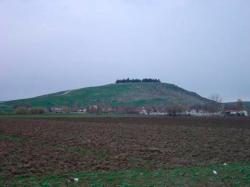 Karditsa - Anyone visiting the Regional Unit of Karditsa and Thessaly for the first time will notice the small hills, which lay in the midst of the Thessalian plain. The majority of these hills are artificial. In Thessaly they are called Magoules (tells). Apart from rare exceptions, where they are burial mounts –and one can distinguish them by their bigger size–, these hills are prehistoric settlements. Most of them date back to the Neolithic Era, while in some cases they show continuous habitation, reaching back to the Bronze Age and rarely to the Historical Times – but in this case with significant discontinuities in habitation. These facts are mentioned in a study written by the Director of the 34th Ephorate of Prehistoric and Classical Antiquities Maria Vaiopoulou. The study makes special reference to the National Road of Athens-Karditsa: “Approximately 20 km from Karditsa we come across one of the best known tells of Western Thessaly, the Magoula Pazaraki or Magoula Agiou Visariona. It is a typical example of a prehistoric Magoula, which –except for some discontinuities– shows uninterrupted habitation. During the excavations conducted there at the end of 1960s, directed by G. Chourmouziadis, Professor of the Aristotle University of Thessaloniki, habitation layers of the Middle Neolithic have come to light. The settlement was destroyed by fire. In 2006 the Magoula was cleaned and excavated by the 34th EPCA. A Middle Neolithic layer of habitation was located, and the foundations of a Hellenistic period temple were revealed. Architectural material from the Hellenistic temple was re-used for the erection of an Islamic shrine. The area was used as an Islamic cemetery during the Post-Byzantine era”. The national road passes over the Magoula, dividing it into a northern and a southern part. The road probably existed during the Post-Byzantine era.
Karditsa - Anyone visiting the Regional Unit of Karditsa and Thessaly for the first time will notice the small hills, which lay in the midst of the Thessalian plain. The majority of these hills are artificial. In Thessaly they are called Magoules (tells). Apart from rare exceptions, where they are burial mounts –and one can distinguish them by their bigger size–, these hills are prehistoric settlements. Most of them date back to the Neolithic Era, while in some cases they show continuous habitation, reaching back to the Bronze Age and rarely to the Historical Times – but in this case with significant discontinuities in habitation. These facts are mentioned in a study written by the Director of the 34th Ephorate of Prehistoric and Classical Antiquities Maria Vaiopoulou. The study makes special reference to the National Road of Athens-Karditsa: “Approximately 20 km from Karditsa we come across one of the best known tells of Western Thessaly, the Magoula Pazaraki or Magoula Agiou Visariona. It is a typical example of a prehistoric Magoula, which –except for some discontinuities– shows uninterrupted habitation. During the excavations conducted there at the end of 1960s, directed by G. Chourmouziadis, Professor of the Aristotle University of Thessaloniki, habitation layers of the Middle Neolithic have come to light. The settlement was destroyed by fire. In 2006 the Magoula was cleaned and excavated by the 34th EPCA. A Middle Neolithic layer of habitation was located, and the foundations of a Hellenistic period temple were revealed. Architectural material from the Hellenistic temple was re-used for the erection of an Islamic shrine. The area was used as an Islamic cemetery during the Post-Byzantine era”. The national road passes over the Magoula, dividing it into a northern and a southern part. The road probably existed during the Post-Byzantine era.
http://www.archaiologia.gr/en/
ROYAUME UNI – 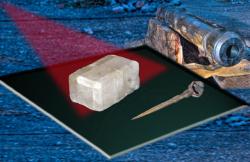 Alderney - In 1592, a British ship sank near the island of Alderney in the English Channel carrying an odd piece of cargo: a small, angular crystal. Though cloudy and scuffed up from 4 centuries at the bottom of the sea, its precise geometry and proximity to the ship's navigation equipment caught the eye of a diver exploring the wreckage. Once it was brought back to land, a few European scientists began to suspect the mysterious object might be a calcite crystal, which they believe Vikings and other European seafarers used to navigate before the introduction of the magnetic compass. A previous study showed that calcite crystals reveal the patterns of polarized light around the sun and, therefore, could have been used to determine its position in the sky even on cloudy days. That led researchers to believe these crystals, which are commonly found in Iceland and other parts of Scandinavia, might have been the powerful "sunstones" referred to in Norse legends, but they had no archaeological evidence to support their hypothesis—until now. After subjecting it to a battery of mechanical and chemical tests, the team determined that the Alderman crystal is indeed a calcite and, therefore, could have been the ship's optical compass, they report online today in the Proceedings of the Royal Society A. Today, similar calcite crystals are used by astronomers to analyze the atmospheres of exoplanets—perhaps setting the stage for a whole new age of exploration.
Alderney - In 1592, a British ship sank near the island of Alderney in the English Channel carrying an odd piece of cargo: a small, angular crystal. Though cloudy and scuffed up from 4 centuries at the bottom of the sea, its precise geometry and proximity to the ship's navigation equipment caught the eye of a diver exploring the wreckage. Once it was brought back to land, a few European scientists began to suspect the mysterious object might be a calcite crystal, which they believe Vikings and other European seafarers used to navigate before the introduction of the magnetic compass. A previous study showed that calcite crystals reveal the patterns of polarized light around the sun and, therefore, could have been used to determine its position in the sky even on cloudy days. That led researchers to believe these crystals, which are commonly found in Iceland and other parts of Scandinavia, might have been the powerful "sunstones" referred to in Norse legends, but they had no archaeological evidence to support their hypothesis—until now. After subjecting it to a battery of mechanical and chemical tests, the team determined that the Alderman crystal is indeed a calcite and, therefore, could have been the ship's optical compass, they report online today in the Proceedings of the Royal Society A. Today, similar calcite crystals are used by astronomers to analyze the atmospheres of exoplanets—perhaps setting the stage for a whole new age of exploration.
http://news.sciencemag.org/sciencenow/2013/03/scienceshot-sunstone-unearthed-f.html?ref=hp